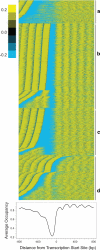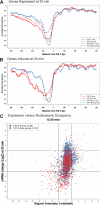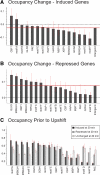Chromatin-dependent transcription factor accessibility rather than nucleosome remodeling predominates during global transcriptional restructuring in Saccharomyces cerevisiae
- PMID: 19494041
- PMCID: PMC2719568
- DOI: 10.1091/mbc.e09-02-0111
Chromatin-dependent transcription factor accessibility rather than nucleosome remodeling predominates during global transcriptional restructuring in Saccharomyces cerevisiae
Abstract
Several well-studied promoters in yeast lose nucleosomes upon transcriptional activation and gain them upon repression, an observation that has prompted the model that transcriptional activation and repression requires nucleosome remodeling of regulated promoters. We have examined global nucleosome positioning before and after glucose-induced transcriptional reprogramming, a condition under which more than half of all yeast genes significantly change expression. The majority of induced and repressed genes exhibit no change in promoter nucleosome arrangement, although promoters that do undergo nucleosome remodeling tend to contain a TATA box. Rather, we found multiple examples where the pre-existing accessibility of putative transcription factor binding sites before glucose addition determined whether the corresponding gene would change expression in response to glucose addition. These results suggest that selection of appropriate transcription factor binding sites may be dictated to a large extent by nucleosome prepositioning but that regulation of expression through these sites is dictated not by nucleosome repositioning but by changes in transcription factor activity.
Figures






Similar articles
-
Transcription factor binding site positioning in yeast: proximal promoter motifs characterize TATA-less promoters.PLoS One. 2011;6(9):e24279. doi: 10.1371/journal.pone.0024279. Epub 2011 Sep 9. PLoS One. 2011. PMID: 21931670 Free PMC article.
-
Chromatin remodelers clear nucleosomes from intrinsically unfavorable sites to establish nucleosome-depleted regions at promoters.Mol Biol Cell. 2011 Jun 15;22(12):2106-18. doi: 10.1091/mbc.E10-10-0826. Epub 2011 Apr 20. Mol Biol Cell. 2011. PMID: 21508315 Free PMC article.
-
Opening windows to the genome.Cell. 2009 May 1;137(3):400-2. doi: 10.1016/j.cell.2009.04.026. Cell. 2009. PMID: 19410536
-
Yeast chromatin remodeling complexes and their roles in transcription.Curr Genet. 2020 Aug;66(4):657-670. doi: 10.1007/s00294-020-01072-0. Epub 2020 Apr 1. Curr Genet. 2020. PMID: 32239283 Review.
-
Establishing nucleosome architecture and stability at promoters: Roles of pioneer transcription factors and the RSC chromatin remodeler.Bioessays. 2017 May;39(5). doi: 10.1002/bies.201600237. Epub 2017 Mar 27. Bioessays. 2017. PMID: 28345796 Review.
Cited by
-
Protein kinase A and TORC1 activate genes for ribosomal biogenesis by inactivating repressors encoded by Dot6 and its homolog Tod6.Proc Natl Acad Sci U S A. 2009 Nov 24;106(47):19928-33. doi: 10.1073/pnas.0907027106. Epub 2009 Nov 9. Proc Natl Acad Sci U S A. 2009. PMID: 19901341 Free PMC article.
-
A dynamic interplay of nucleosome and Msn2 binding regulates kinetics of gene activation and repression following stress.Nucleic Acids Res. 2014 May;42(9):5468-82. doi: 10.1093/nar/gku176. Epub 2014 Mar 5. Nucleic Acids Res. 2014. PMID: 24598258 Free PMC article.
-
Nucleosome positioning in Saccharomyces cerevisiae.Microbiol Mol Biol Rev. 2011 Jun;75(2):301-20. doi: 10.1128/MMBR.00046-10. Microbiol Mol Biol Rev. 2011. PMID: 21646431 Free PMC article. Review.
-
A genomic model of condition-specific nucleosome behavior explains transcriptional activity in yeast.Genome Res. 2012 Jan;22(1):84-94. doi: 10.1101/gr.124099.111. Epub 2011 Sep 19. Genome Res. 2012. PMID: 21930892 Free PMC article.
-
Nucleosome positioning in yeasts: methods, maps, and mechanisms.Chromosoma. 2015 Jun;124(2):131-51. doi: 10.1007/s00412-014-0501-x. Epub 2014 Dec 23. Chromosoma. 2015. PMID: 25529773 Review.
References
-
- Agricola E., Verdone L., Xella B., Di Mauro E., Caserta M. Common chromatin architecture, common chromatin remodeling, and common transcription kinetics of Adr1-dependent genes in Saccharomyces cerevisiae. Biochemistry. 2004;43:8878–8884. - PubMed
-
- Albert I., Mavrich T. N., Tomsho L. P., Qi J., Zanton S. J., Schuster S. C., Pugh B. F. Translational and rotational settings of H2A.Z nucleosomes across the Saccharomyces cerevisiae genome. Nature. 2007;446:572–576. - PubMed
-
- Basehoar A. D., Zanton S. J., Pugh B. F. Identification and distinct regulation of yeast TATA box-containing genes. Cell. 2004;116:699–709. - PubMed
-
- Beer M. A., Tavazoie S. Predicting gene expression from sequence. Cell. 2004;117:185–198. - PubMed
Publication types
MeSH terms
Substances
Grants and funding
LinkOut - more resources
Full Text Sources
Other Literature Sources
Molecular Biology Databases

